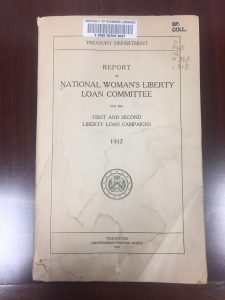“Report of 1917” was the title of the pamphlet that intrigued me immediately. The pamphlet, a product of the Treasury Department, presents an extensive report in three parts about the efforts of a women exclusive committee to raise Liberty Bonds for the war efforts. Part one gives the structure and leadership of the committee, which were highly organized into localities across the nation. Part two reports on past campaigns and methods, of which I found the most notable references “Cooperation With Government Departments” and “Special Features”. Part three looks forward to goals, savings and future methods to raise liberty loans. This pamphlet is an example of large scale organization of individuals that were voluntarily serving the federal government’s mobilization effort. An additional historical element of this pamphlet is how it fits into the trend of women’s behavior and efforts during the war.
Women working towards the war effort tended to organize in private chapters but this effort of liberty bonds was uniquely close to federal government for a women’s organization. Interestingly, Mrs. McAdoo served as the chairman (rather chairwoman) of the committee whose husband, William McAdoo, was Secretary of the Treasury. This connection poses questions but the pamphlet reveals nothing regarding the implications of nepotism. In the introduction of the pamphlet, the committee thanks the secretary of Treasury for the opportunity stating “first time in history… the United States has appointed a national women’s Committee, giving it the same recognition and privilege as other committees of his department”(6). The government did give these women a significant job but I would question if they truly received the same “recognition and privilege” as other all male counterparts. Regardless, they conveyed their gratitude to the patriarchal government for the opportunity and proceded to do their duty in traditionally female way.
Large parts of this pamphlet were mostly bureaucratic for the Treasury Department, but the most interesting aspect were the descriptions of the events the women organized. The committees across the country organized events to raise liberty bonds with school children, parades and other lighthearted events, making their activities traditionally maternal and feminine. One example of this can be seen in a school district in Detroit in which representatives from the National Woman’s Liberty Loan Committee went to English courses and the children devoted their time to liberty loan work, writing speeches and drawing. The children then gave said speeches to different rooms of adults and raised $1,500,000 (32). Another effort of the committee was in Illinois where the Governor consented to give 3American flags to the school district with the greatest number of bonds sold. The school districts raised $1,130,350 (32). In addition to these school-centered efforts, the Women’s Committee put on community parades with patriotic flare to raise liberty bonds (33). The work of the National Woman’s Liberty Loan Committee was not limited to these type of projects, but they were a significant aspect of their efforts. This behavior fits into a national trend in which women worked through the maternal domain, schools and children, to their achieve their goals and the goals of the nation.


Yes! Definitely an example of organized “voluntarism” (within the bounds of patriarchy).